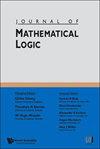驯服阿贝尔产品组的行为
IF 0.9
1区 数学
Q1 LOGIC
引用次数: 1
摘要
如果对于$G$的任何连续作用,对应的轨道等价关系为Borel,则波兰群$G$是驯服的。当$G = \prod_n \Gamma_n$为可数阿贝尔量$\Gamma_n$时,Solecki(1995)给出了$G$为驯服时的表征。Ding和Gao(2017)认为对于这种$G$,轨道等价关系实际上必然是潜在的$\mathbf{\Pi}^0_6$,同时推测最优界可能是$\mathbf{\Pi}^0_3$。我们通过构造这样一个群的一个动作$G$而不是潜在的$\mathbf{\Pi}^0_5$来证明最优界是$D(\mathbf{\Pi}^0_5)$,并展示了如何修改Ding和Gao的分析来得到这个稍微好一点的上界。接着,使用Hjorth, Kechris和Louvaeu(1998)的结果,这是驯服阿贝尔产品群行为的潜在复杂性的最优界。我们的下界分析涉及对有限集合序列的选择失败的集合理论模型的强迫。本文章由计算机程序翻译,如有差异,请以英文原文为准。
Actions of tame abelian product groups
A Polish group $G$ is tame if for any continuous action of $G$, the corresponding orbit equivalence relation is Borel. When $G = \prod_n \Gamma_n$ for countable abelian $\Gamma_n$, Solecki (1995) gave a characterization for when $G$ is tame. Ding and Gao (2017) showed that for such $G$, the orbit equivalence relation must in fact be potentially $\mathbf{\Pi}^0_6$, while conjecturing that the optimal bound could be $\mathbf{\Pi}^0_3$. We show that the optimal bound is $D(\mathbf{\Pi}^0_5)$ by constructing an action of such a group $G$ which is not potentially $\mathbf{\Pi}^0_5$, and show how to modify the analysis of Ding and Gao to get this slightly better upper bound. It follows, using the results of Hjorth, Kechris, and Louvaeu (1998), that this is the optimal bound for the potential complexity of actions of tame abelian product groups. Our lower-bound analysis involves forcing over models of set theory where choice fails for sequences of finite sets.
求助全文
通过发布文献求助,成功后即可免费获取论文全文。
去求助
来源期刊

Journal of Mathematical Logic
MATHEMATICS-LOGIC
CiteScore
1.60
自引率
11.10%
发文量
23
审稿时长
>12 weeks
期刊介绍:
The Journal of Mathematical Logic (JML) provides an important forum for the communication of original contributions in all areas of mathematical logic and its applications. It aims at publishing papers at the highest level of mathematical creativity and sophistication. JML intends to represent the most important and innovative developments in the subject.
 求助内容:
求助内容: 应助结果提醒方式:
应助结果提醒方式:


